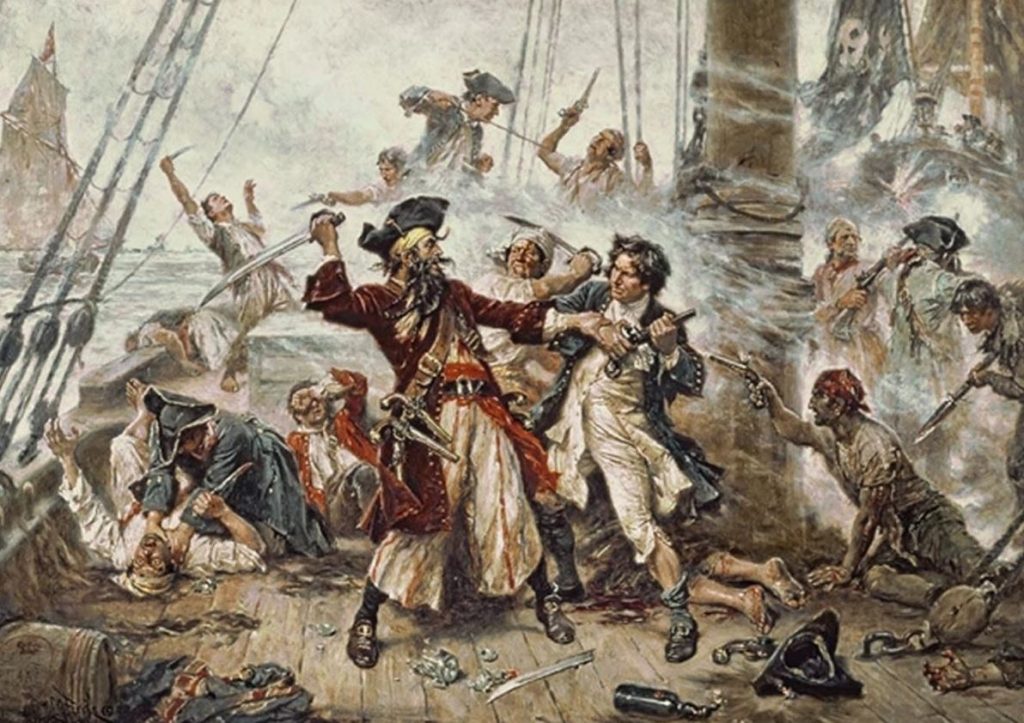The period from 1630 to 1730 is considered the golden age of piracy and Rhode Island was a major haven for buccaneers. The wars between England, Holland, and France gave rise to privateers who were licensed by their respective governments to raid enemy shipping. This pretext to raid enemy ships was nothing less than legalized piracy. When the wars were over very few seamen wanted to go back to the life of a sailor. Sailors of the time were treated like slaves with severe punishment for minor offenses, fed terrible food, and had no prospect of improving their lives. Rhode Island became a center for piracy with ships being outfitted, privateer letters of marquee given by corrupt officials, and goods and services bought and sold, all without paying taxes to England. Critics of the time sometimes referred to Rhode Island as “Rogue’s Island” and Cotton Mather of the Massachusetts Bay Colony called it “the sewer of New England.”

To supplement their crews, it was common practice for pirates to force seamen from the captured ships to join their crew. Sometimes the forced seamen grew to like the rover life and became pirates themselves, others refused to participate only unwillingly. Some of the forced men did become wealthy but many more died either by the blade of a cutlass or the hangman’s noose. In 1682 Samuel Cranston, who would become Rhode Island’s longest-serving governor, became one of these forced men.
Samuel Cranston was the son of former Rhode Island Governor John Cranston. He was born in Newport and lived there his entire life. At age twenty-one he married Mary Hart, the granddaughter of Roger Williams, thus uniting the two powerful political families of Newport. The war with France had left Samuel with few financial prospects so he decided to pursue business interests in the Caribbean. Cranston purchased a ship, hired a captain and crew, and set sail for the Caribbean. Soon after arriving off Key West, Florida a pirate ship was sighted. The pirates demanded complete surrender but Cranston’s captain decided to resist. A fierce battle ensued but the pirate’s superior numbers soon won the battle. Enraged by the captain’s resistance, the pirates murdered the entire crew except for Cranston.
Cranston would remain a prisoner of the pirates for seven long years. After capture, he was brought to an island off the coast of Honduras where the pirates had their stronghold. After being treated like a slave all Cranston could dream about was getting back to the new bride he’d left behind. When an opportunity finally came, he was able to outfit a small boat and escape the island. He sailed for six days until he spotted a merchant ship, was rescued, and then brought to Halifax, Nova Scotia. The crew donated money for Cranston to book passage to Boston. Upon arriving in Boston, he learned that his wife Mary, thinking him dead, was about to marry another man.
Having no money left Cranston walked to Newport driven on by his need to arrive before his wife married a Mr. Russell from Boston. According to some accounts he arrived on the day of the wedding so dirty and bedraggled that he was not recognized in his own home. Thinking him a beggar he was taken in and fed by the servants. He asked to see the mistress of the house saying he had a message from her husband. After being escorted to Mary he told the story of the capture and escape, finally revealing himself. He proved his identity by showing Mary a distinguishing scar on his forehead. Mary was overjoyed and the marriage ceremony was turned into an event celebrating his return.
Cranston was in his late 30s when he began his political career. With no political experience, he was selected as Governor of the colony in 1698. Cranston was the 18th Governor of the Colony of Rhode Island and Providence Plantations. He served as governor for twenty-nine years until he died in 1727. He was elected to office thirty times and served as governor longer than any other individual in the history of the colony and the State of Rhode Island. Cranston presided over the transformation of Rhode Island from a struggling group of villages to a flourishing agricultural province. Cranston’s most notable accomplishment was to bring his colony into a working relationship with the imperial government in London while preserving the colonies’ charter.
Samuel and his first wife Mary had seven children. After Mary died in 1710 he married Judith Parrett, his brother’s widow. Upon his death in 1727 Samuel Cranston was buried in the Common Burying Ground in Newport. He shares a large marker with his father John Cranston.
Perhaps it’s not so remarkable that Rhode Island has had such a history of piracy for it has been the refuge of non-conformists and outcasts going back to its founding by Roger Williams. Many people agreed about Rhode Island’s bad reputation including Dutch historian Thomas Janvier. He called Rhode Island “the abode of notorious hard characters” and referred to some of its citizens as “loose fish of thievish proclivities.” The phrase queer fish and loose fish came to mean a man of doubtful character, which began the expression “fishy.” So, if something or someone seems fishy to you, you can blame it on Rogue’s Island.
